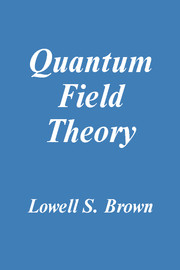3 - Elementary scalar field theory
Published online by Cambridge University Press: 05 August 2012
Summary
This chapter introduces the simplest example of a relativistic field theory, that provided by a scalar (spin zero) field. First we consider the free, noninteracting theory. After making contact with the non-relativistic, particle creation and destruction fields of the previous chapter, the relativistic, free-particle propagation functions are described. The interacting theory is then examined by computing the two-particle scattering cross section in lowest order. Using the general structure of the scattering amplitude, which is illustrated by the simple scalar theory, we derive a formula for the cross section that is easily generalized to any two-particle scattering process. This we do with some rigor by using a wave-packet technique. This discussion is an example of what will often be done in subsequent chapters: The scalar field theory will be employed to motivate and illustrate many features of relativistic quantum field theory that hold in general. We use the scalar field so as to make these features clear and not encumbered with complicated notation. This chapter also contains the calculation of the scalar-scalar scattering cross section to second order. This requires regularization — which we do by the method of dimensional continuation — and renormalization. The renormalization is done with a method that naturally leads to the idea of the running coupling constant which is of great importance in modern elementary particle theory.
- Type
- Chapter
- Information
- Quantum Field Theory , pp. 129 - 191Publisher: Cambridge University PressPrint publication year: 1992



